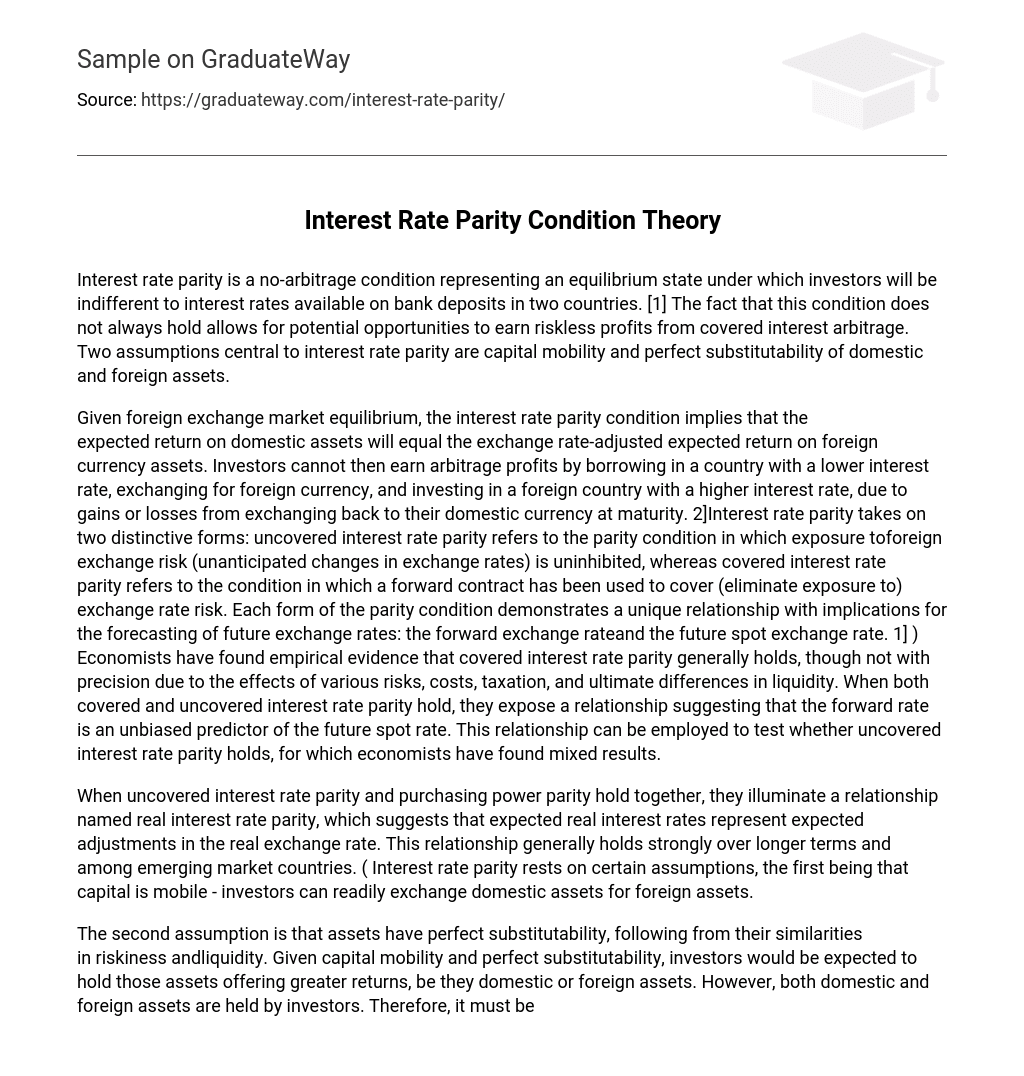Interest rate parity is a no-arbitrage condition representing an equilibrium state under which investors will be indifferent to interest rates available on bank deposits in two countries. The fact that this condition does not always hold allows for potential opportunities to earn riskless profits from covered interest arbitrage. Two assumptions central to interest rate parity are capital mobility and perfect substitutability of domestic and foreign assets.
Given foreign exchange market equilibrium, the interest rate parity condition implies that the expected return on domestic assets will equal the exchange rate-adjusted expected return on foreign currency assets. Investors cannot then earn arbitrage profits by borrowing in a country with a lower interest rate, exchanging for foreign currency, and investing in a foreign country with a higher interest rate, due to gains or losses from exchanging back to their domestic currency at maturity.
Interest rate parity takes on two distinctive forms: uncovered interest rate parity refers to the parity condition in which exposure toforeign exchange risk (unanticipated changes in exchange rates) is uninhibited, whereas covered interest rate parity refers to the condition in which a forward contract has been used to cover (eliminate exposure to) exchange rate risk. Each form of the parity condition demonstrates a unique relationship with implications for the forecasting of future exchange rates: the forward exchange rateand the future spot exchange rate.
Economists have found empirical evidence that covered interest rate parity generally holds, though not with precision due to the effects of various risks, costs, taxation, and ultimate differences in liquidity. When both covered and uncovered interest rate parity hold, they expose a relationship suggesting that the forward rate is an unbiased predictor of the future spot rate. This relationship can be employed to test whether uncovered interest rate parity holds, for which economists have found mixed results.
When uncovered interest rate parity and purchasing power parity hold together, they illuminate a relationship named real interest rate parity, which suggests that expected real interest rates represent expected adjustments in the real exchange rate. This relationship generally holds strongly over longer terms and among emerging market countries. ( Interest rate parity rests on certain assumptions, the first being that capital is mobile – investors can readily exchange domestic assets for foreign assets.
The second assumption is that assets have perfect substitutability, following from their similarities in riskiness andliquidity. Given capital mobility and perfect substitutability, investors would be expected to hold those assets offering greater returns, be they domestic or foreign assets. However, both domestic and foreign assets are held by investors. Therefore, it must be true that no difference can exist between the returns on domestic assets and the returns on foreign assets.
That is not to say that domestic investors and foreign investors will earn equivalent returns, but that a single investor on any given side would expect to earn equivalent returns from either investment decision ) A visual representation of uncovered interest rate parity holding in the foreign exchange market, such that the returns from investing domestically are equal to the returns from investing abroad.
When the no-arbitrage condition is satisfied without the use of a forward contract to hedge against exposure to exchange rate risk, interest rate parity is said to be uncovered. Risk-neutral investors will be indifferent among the available interest rates in two countries because the exchange rate between those countries is expected to adjust such that the dollar return on dollar deposits is equal to the dollar return on foreign deposits, thereby eliminating the potential for uncovered interest arbitrage profits.





